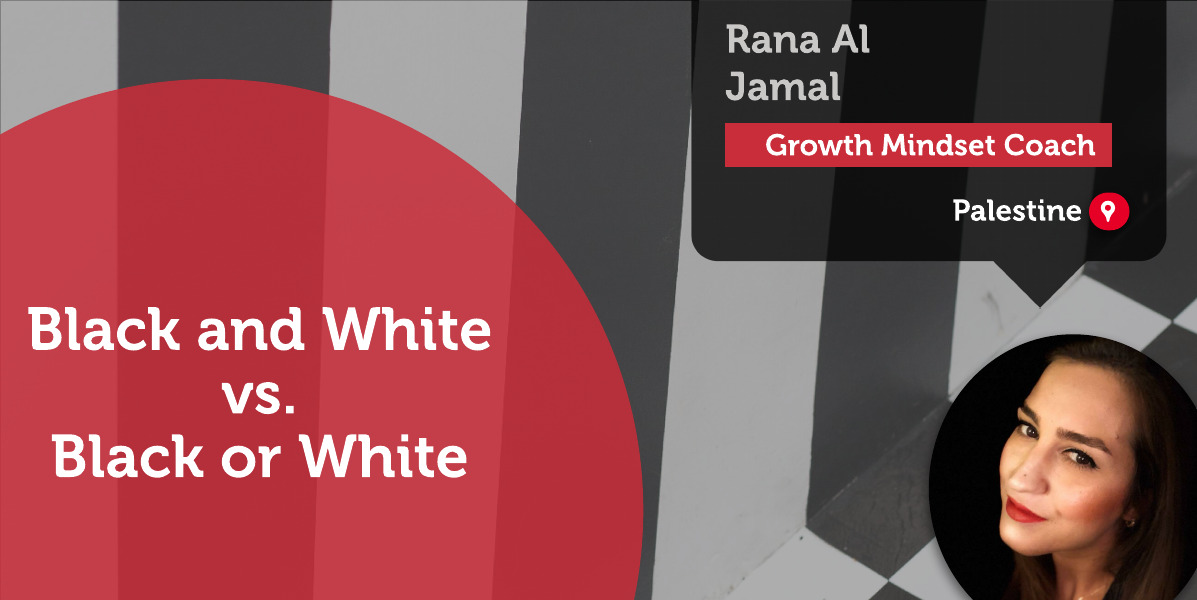A Coaching Power Tool By Rana Al Jamal, Growth Mindset Coach, PALESTINE

Ring the bells that still can ring
Forget your perfect offering
There is a crack in everything
That’s how the light gets in.― Leonard Cohen
The Difference Between Black and White vs. Black or White
The different term of black & white thinking is “dichotomous thinking”. When you are using dichotomous thinking, it means you are looking at everything as an either-or situation. You only see good or bad, right, or wrong, but nothing in the middle. There is no gray area for you because you see everything as only one way or the other.[1]
The Impact of Black or White Thinking on Ourselves
We all have a tendency sometimes to forget all the good things that we have and focus on the bad. This kind of thinking could be very stressful and harm our emotions and it can lead to feeling helpless and create excuses to be responsible.
When accomplishing %80 of our plan for the week without appreciating ourselves and focusing on the %20 without taking into consideration the accomplishment we have done. When one bad thing happens to us during the day and we forget that we woke up and opened our eyes healthy, that we are breathing and our family is fine, our work is stable, and that we have something to eat and a place to live we simply say, “I had a bad day”, we forget very easily the many good things we have and remember only the one bad thing that happened. In my opinion, the mistake we do is that we take all the things mentioned for granted. If we think deeply, we will find that nothing in our life is for granted. Anything can be changed anytime out of nowhere…
The Impact of Black or White Thinking on Others
Having black or white thinking can harm our relationships whether it is family, friends, neighbors, co-workers by suddenly moving people from the “good person” category to the “bad person” category. At work, it could lead to firing people and it causes relationships breaking. Using this kind of thinking is usually limiting any type of negotiation or finding efforts for solutions. It invites also other people to be defensive because they feel attacked when we say for example you never did… you always do…[2]
How to Flip Black or White Thinking to Black & White in Coaching
I like how Brook Castillo in her podcast “All or Nothing” is flipping “Or” to “And”. She said when we understand that life is about succeeding and failing, getting it right and getting it wrong, being a good person sometimes and being a bad person sometimes, then there is a freedom in that, in being able to use the word “And”, instead of “Or”.[3]
The curious paradox is that when I accept myself just as I am, then I can change — Carl Rogers.
Starting with ourselves is always the key to any change. Having the courage and being honest with ourselves is very important. Accepting and recognizing our mistakes or failures can be helpful to accept that others also do mistakes and fail.
- What was the last mistake you did? How did you try to solve it?
- Describe some characters you have you don’t like? What is a good character that you have?
- When was the last time you felt sad? When was the last time you felt happy?
Digging deep by this kind of questioning can help the client to recognize and most importantly accept that no one is perfect or has a perfect life. We are surrounded and exposed to many negative things, but the trick is to be aware that our brain is like a muscle we need to feed it with positive thoughts once the negative thoughts start working, we need to start focusing and reminding ourselves with all the good things we have and are happening. Very helpful is also think about all good things that we take for granted and think what if they are gone, what would our life look like?
Coaching and Growth Mindset
Helping the client to see the failure not as evidence of unluckiness of unintelligence but as a heartening springboard for growth and for stretching the existing abilities would be very helpful by asking questions that are focusing on turning the bad experience that might be facing the client into a good one;
- What did you learn from this situation?
- What did you learn about yourself?
- How can this learning help you?
- How can you turn this learning into action?
Using the “LIFE” Model
I found that using my “LIFE” model would be helpful for this subject.
L – Life is not perfect but is full of opportunities. Choose an opportunity from those which is life offering you and work on it.
I – Imperfection is part of life. No one is perfect and it is fine. Find your strengths and work on them.
F – Feelings are our indicator for our physical emotions. Change the perceptions that are having a bad impact on your emotions.
E– Exploration is life. Explore the possibilities, actions, feelings.
Life is grey and full of shadows. There is no color without a degree even black and white have different shades. We are a part of nature which has 4 seasons, and every day is different it could be windy, rainy, sunny, cold, hot, and sometimes we face all those changes in one day. We as humans are not different. Our emotions are flexible and influenced by all the natural things that happen around us. We need to accept that and be able to grow and be open to learning to stay in the middle by accepting reality and taking life as beautiful, difficult, complicated, joyful, and painful. There is no perfect job, no perfect marriage, and no perfect person.
References
[1]https://www.betterhelp.com/
[2]https://www.healthline.com/
[3]https://www.youtube.com/